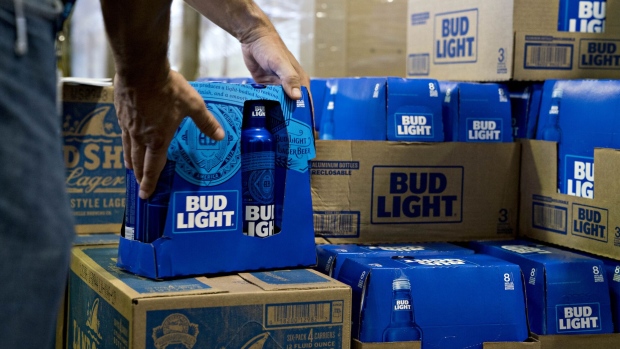Oct 31, 2023
AB InBev Keeps Forecast as Bud Light Snafu Erodes US Sales
, Bloomberg News

(Bloomberg) -- Three of the world’s biggest brewers are confident they can hit profit targets this year even as drinkers in many parts of the world pull back on buying beer following a prolonged period of inflation.
Anheuser-Busch InBev NV and Carlsberg A/S stuck to their forecasts Tuesday and separately announced share buybacks in a sign of confidence that any dip in consumer sentiment will not last long. Last week, Heineken NV also held the line on profit and said demand will gradually recover, noting that in half of its markets volume trends are already starting to improve.
Brewers have been raising prices to offset surging ingredient and production expenses but it can be a delicate balancing act as some consumers have been cutting back on discretionary purchases as they face higher mortgage payments and energy costs.
AB InBev, the maker of Budweiser and Stella Artois, reported a 5% jump in revenue in the third quarter, almost entirely driven by higher beer prices. Revenue per hectoliter, a measure of pricing power, rose 9% during the period, the company said. Volumes fell more than expected, however, hit by the fallout of a US marketing controversy and a wet summer in Europe.
Read More: Bud Light Seeks Comeback From Controversy With New Campaign
The Leuven, Belgium-based company still expects earnings to rise 4% to 8% this year and announced a $1 billion share buyback, sending a message that the “company views its share price as attractive and points to balance sheet repair,” according to Edward Mundy, an analyst at Jefferies.
It’s a similar story at Carlsberg, the maker of Tuborg, which maintained a full-year target of 4% to 7% operating profit growth and announced a new 1 billion kroner ($143 million) share buyback, despite volumes falling twice as much as analysts expected. Overall revenue per hectoliter rose 9% as Carlsberg increased prices.
Beer volumes at Heineken fell by 4.2% in the third quarter as shipments to key markets including Vietnam, Nigeria and much of Europe declined, while premium beer volumes fell even further.
Heineken Chief Executive Officer Dolf van den Brink pointed to turbulent conditions and said it’s remaining vigilant on costs as “inflation-led pricing is tapering.”
Read More: Heineken Keeps Profit Outlook Even as Drinkers Pull Back
In a sign that brewers may have hit peak pricing power, while all three companies have maintained their outlook, none have tightened fairly broad target ranges even though there are only two months left to the fiscal year. AB InBev’s “lack of narrowing of the guidance range points to the volatile external environment,” said Mundy.
Carlsberg held its profit outlook steady as there’s still a question mark about the strength of the consumer, Ulrica Fearn, Carlsberg’s chief financial officer said on a call with analysts.
“Generally the consumer environment is the biggest uncertainty out there, which is why we kept the range,” she said.
Carlsberg is increasing its commercial investment spending, including marketing, by about 200 million kroner for the rest of the year to help accelerate growth, said CEO Jacob Aarup-Andersen, who took charge in September. He said the company’s costs are still rising heading into 2024 and “as a consequence we do not expect to see price declines.”
AB InBev has also ramped up marketing spend, particularly in the US, where third-quarter sales dropped 14% amid the Bud Light row. Dylan Mulvaney, a transgender influencer, did a sponsored Instagram post for Bud Light in April, which led to a backlash among political conservatives in the US. AB InBev subsequently cut ties with Mulvaney, which triggered the ire of her supporters.
The company recently signed a multiyear sponsorship deal with the Ultimate Fighting Championship as part of efforts to rebound from the boycott-driven sales decline.
What Bloomberg Intelligence Says:
AB InBev has got to stabilize Bud Light volume or cash generation may suffer as the troubles in the US market have shaved $834 million off Ebitda in 2023, with US volume down 11.2% and 1.4% worldwide over nine months. AB InBev has always used pricing to bolster cash flow, which enabled the company to both tender to buy back $3 billion of bonds and initiate a $1 billion share buy-back. — Duncan Fox, BI consumer-products analyst
AB InBev Must Stem US Profit Decline or Cash Flow Crushed: React“
AB InBev stock rose as much as 4%, while Carlsberg was down 1.4%. Heineken was little changed.
--With assistance from Andy Hoffman.
(updates with quotes from Carlsberg analyst call)
©2023 Bloomberg L.P.


